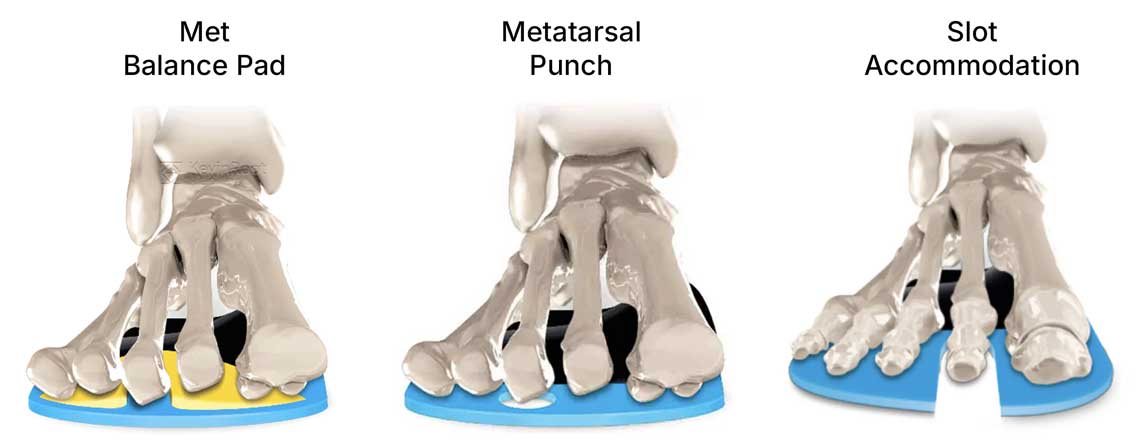This episode of our journey through the FootID Pro Configurator leads us to the area of “Pads and Cushions” that address primarily the plantar forefoot in and around the distal metatarsal and metatarsal head region. Various foot pathologies are common sources of pain and disability in the plantar forefoot, including callus/blister formation, metatarsalgia, lack of fat pad, capsulitis of the lesser metatarsophalangeal joints, subluxation/dislocation of the lesser MTP joints, plantar plate disruption, flexible and rigid hammertoe deformities, intermetatarsal neuroma, plantar bursitis, plantar fibroma, stress reaction/fracture of the metatarsals, plantarflexed/elongated metatarsals, brachymetatarsia, as well as various other unusual presentations such as soft tissue masses. We will review the available accommodations that mostly are part of the orthotic extension, so you can choose within the configurator to effective strategy to alleviate your patient’s forefoot condition.

The next field in “Pads and Cushions” is the Met Balance Pad. A metatarsal balance is a 3mm Myolite forefoot padding that sits on top of an extension and extends from the superior distal edge of the orthotic frame, terminates distally to the metatarsal heads and has a parabolic aperture that offloads a bony or soft-tissue prominence. The curved side of the aperture is just proximal to the metatarsal head, straightens at the adjacent interspaces. The inside edges of aperture’s negative space are unskived while the outer edges are all blended. The metatarsal balance pad can be used to accommodate an individual or multiple metatarsal heads in case of hyperkeratosis, metatarsalgia or stress reaction. It is available in various thicknesses, and by clicking on the Right/Left or Bilateral buttons you can select specific locations for your balance pads.
The Metatarsal Punch is slightly different than the metatarsal balance pad. It can used in lieu of the balance pad when less bulk within the extension is desired. A metatarsal punch is a circular aperture made in a Myolite forefoot padding inferior to the target metatarsal head. The aperture is made all the way through the Myolite’s thickness. Accommodates and offloads metatarsal heads without additional forefoot bulk. Clinically indicated for bony or soft-tissue metatarsal head prominence, plantar corn, callus or wart, hyperkeratosis, prominent metatarsal head, and ulceration. Clicking on the chain link option will give you the ability to select left or right only and which metatarsal head you wish to accommodate on either foot.
Skipping down a few fields we arrive at “Slot Accommodation". A slot accommodation creates an aperture within an extension, and extends from the selected metatarsal head(s) to the distal end of the extension. The aperture is circular at the proximal end to match the circumference of the metatarsal head and extends distal in a rectangular fashion to the end of the toes. The slot accommodates and off loads metatarsal heads and toes without additional forefoot bulk. Clinical Indication for bony or soft-tissue metatarsal head prominence, plantar corn, callus or wart on methead or toe, hyperkeratotic lesion, plantarflexed metatarsal head, ulcer, claw toe. It is especially useful in rigid, non-reducible contracted toes. Since the metatarsal slot accommodation is a cutout for the entire ray segment (metatarsal head and digit) it is my favorite when treating post metatarsal stress fracture particularly if “floating toe” or hammertoe is present. A useful pearl here is to backfill the slot with a soft plastazote of the same thickness as the myolite to add some cushioning but not add bulk. As a reminder, we also have the “Foot Cookie Extension” which is basically a slot accommodation for the central three metatarsals
The next post in this series will address the 2-4 metatarsal pad (good for reducible contracted toes and preventing forward sliding), the metatarsal bar, the neuroma pad, toe crest, and the valgus onlay pad.






